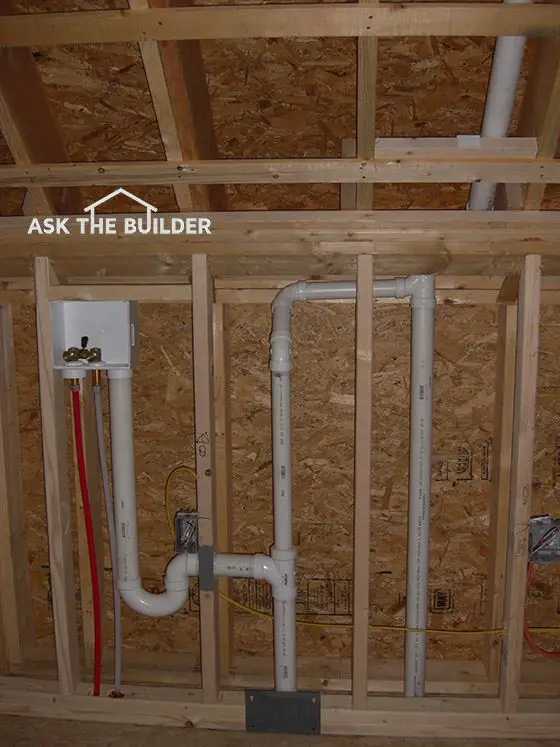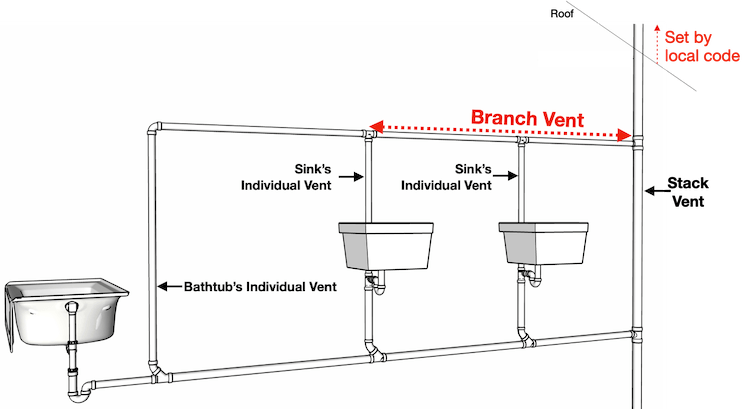The Essential Role of Correct Ventilation in Plumbing Systems
The Essential Role of Correct Ventilation in Plumbing Systems
Blog Article
Each person will have their own unique assumption when it comes to What Are Plumbing Vents and Why Are They Important?.

Correct air flow in plumbing systems is frequently forgotten, yet it is critical for keeping the functionality and safety and security of your home's plumbing. Air flow aids manage atmospheric pressure, protect against the accumulation of dangerous gases, and guarantee the reliable removal of waste. In this guide, we will discover the significance of proper pipes air flow, just how it works, and the advantages it brings to your pipes system.
Comprehending Ventilation in Plumbing
Air flow in pipes refers to the network of pipelines that permit air to stream with the drainage system. These vents serve several functions, consisting of controling atmospheric pressure within the pipelines, avoiding drain gases from getting in the home, and aiding in the smooth flow of wastewater.
Exactly How Ventilation Functions in Pipes Systems
Air Pressure Guideline
Proper air flow maintains well balanced air pressure within the plumbing system. When water streams via pipes, it displaces air. Without ample air flow, this variation can develop unfavorable pressure, bring about reduce drains pipes or siphoning of water from traps, which can cause undesirable odors to permeate right into the home.
Avoiding Drain Gas Accumulation
One of the most important features of pipes vents is to stop drain gases, such as methane and hydrogen sulfide, from building up within the home. These gases can position serious health dangers and are highly combustible. Vent pipelines permit these gases to run away securely outside.
Assisting in Waste Elimination
Ventilation aids in the effective removal of wastewater by stopping airlocks in the drainage system. When air can flow easily via the vents, it permits water and waste to flow efficiently via the pipelines, minimizing the threat of obstructions and backups.
Kinds Of Plumbing Vents
Main Stack Vent
The main stack air vent, also referred to as the vent pile, is the main vent in a pipes system. It extends from the main drain line up with the roofing system, permitting gases to run away and fresh air to enter the system.
Branch Vent
Branch vents connect to the primary stack air vent and serve private fixtures, such as sinks, toilets, and showers. These vents make certain that each component has ample air flow to work properly.
Air Admission Valve (AAV).
An Air Admittance Shutoff (AAV) is a one-way valve that permits air to get in the pipes system without the requirement for a traditional vent pipeline expanding with the roofing system. AAVs are generally utilized in renovations or locations where mounting a conventional vent is impractical.
Indicators of Poor Ventilation in Plumbing.
Slow Draining Fixtures.
If your sinks, tubs, or commodes are draining slowly, maybe a sign of bad air flow. Insufficient air flow can create a vacuum cleaner result, making it difficult for water to drain pipes properly.
Gurgling Seems.
Gurgling noises coming from drains pipes are frequently a result of air being sucked with water catches due to unfavorable stress in the pipes. This is a clear sign of not enough air flow.
Undesirable Odors.
Sewer smells inside your home are a red flag that your pipes system is not effectively aerated. This might indicate that sewage system gases are not being properly vented outside, leading to possibly unsafe conditions.
Usual Ventilation Blunders.
Insufficient Vent Sizing.
Making use of undersized vent pipelines can lead to bad air circulation and stress discrepancies in the system. It's essential to make use of vents that satisfy the details requirements of your pipes system.
Improper Vent Placement.
Putting vents as well much from the fixtures they serve can reduce their performance. Appropriate placement guarantees that air can stream openly and effectively with the system.
Ignoring Code Demands.
Building codes provide certain guidelines for plumbing ventilation. Ignoring these codes can cause a system that falls short to work appropriately and may cause expensive repair services or health hazards.
Benefits of Proper Air Flow.
Enhanced System Performance.
Correctly ventilated pipes systems operate much more efficiently, with fewer blockages, faster draining, and less strain on the pipelines. This efficiency extends the life-span of the pipes system.
Improved Air Quality.
By preventing drain gases from entering your home, appropriate air flow contributes to far better indoor air quality, making your living atmosphere healthier and more comfortable.
Protecting Against Water Damage.
Ample air flow aids prevent water from being siphoned out of catches, which can result in sewage system gases going into the home and triggering water damage with time.
Steps to Ensure Correct Ventilation.
Consulting Pipes Codes.
Constantly seek advice from regional pipes codes when making or changing your pipes system. These codes supply the required guidelines for appropriate venting and guarantee your system satisfies safety and security standards.
Regular Inspection and Maintenance.
Regular assessments can aid identify potential ventilation problems prior to they end up being significant problems. Upkeep jobs, such as cleaning air vent pipes and looking for clogs, are crucial for keeping the system in good working order.
Professional Installation.
For brand-new installments or major adjustments, it's a good idea to employ a professional plumbing. They have the proficiency to make sure the ventilation system is properly created and set up according to code.
Conclusion.
Proper air flow is a critical part of any kind of pipes system, ensuring that it functions successfully and safely. By recognizing the significance of air flow, recognizing the indicators of inadequate air flow, and taking actions to preserve your system, you can prevent expensive problems and safeguard your home's air top quality.
4 Things You Should Know About Your Plumbing Vents
What Plumbing Vents Are
Also called a vent stack, a plumbing vent is a vertical pipe attached to your drain line that runs through your roof. The plumbing vent pipe, or plumbing air vent, removes gas and odors from your plumbing system and allows fresh air to enter the pipes, helping the water to flow out of the drain pipes.
What Plumbing Vents Do
Plumbing vents have two basic functions. One of which is to allow unpleasant smelling wastewater and sewer gasses to escape your plumbing system instead of entering your home. Plumbing vent pipes are typically located on roofs, away from windows, to ensure the fumes exit the home completely.
The other function of the plumbing vent is to move fresh air into your plumbing system. This helps move water through every plumbing fixture in your house, like toilets and sink drains. Think of the way in which you need to let a little air into the bottle as you pour soda in order to make the drink flow smoothly.
Different Types of Plumbing Vents
True vent: This is the most common vent option. In simplest terms, a true vent is a vertical pipe attached to your drain line that exits through the roof. They often function as the main vent that other fixtures can connect to. Re-vent pipe or auxiliary vent: Attached to the drain line near specific plumbing fixtures, re-vent pipes run up and over to connect to the main vent. Common vent: Two plumbing fixtures installed on opposite sides of a wall are typically tied into the vent stack using something known as a sanitary cross. Wet vent: This venting option operates as a drain pipe and a vent at the same time. Wet vent drainage systems drain water from one fixture while venting the air from another. Although they’ve been used for over 100 years, wet vent systems have only recently been added to the plumbing code in many areas. If you’re planning on installing one in a bathroom remodel, make sure you check your local code prior to construction. Loop vent: For free-standing fixtures like kitchen island sinks, loop vents are ideal. These vent pipes run under the floor, rise from the P-trap, and create a loop inside the cabinet sink. Air admittance valve: An AAV is a one-way mechanical valve typically installed at the site of the plumbing fixture. AAVs allow venting to occur without having to tie into a larger venting system. They’re ideal for venting fixtures where you aren’t able to easily connect to an existing vent system. Common Plumbing Vent Issues
Although vent pipes typically don’t have water flowing through them, they’re still subject to many typical plumbing issues. For example, clogs are one of the most common problems associated with sewer vent pipes. If your vent pipe gets clogged, all of your plumbing fixtures tied into the vent stack will be affected.
A sink with a slow drain that bubbles and gurgles or a strong sewage smell around your toilet are both indicators that your toilet vent pipe is clogged. Because most vent pipes exit through the roof, old leaves, twigs or even a bird’s nest could be clogging the pipe.
Clogs in your vent pipe system cause a buildup of negative pressure, meaning that water won’t be able to flow out of your home very well. It’s similar to putting your finger over the opening of a straw to trap water inside. When you remove your finger, the water is able to flow out of the straw.
If you suspect you have any blockage in your vent, make sure you have a professional come examine the situation. Left unchecked, a blocked air vent can lead to other costly repairs, like leaks and sediment buildup.
Under Pressure
Pipe vents are essential aspects of a home’s plumbing system. Owning a home means learning about all sorts of things you never put much thought into before. But by understanding as much as you can about the important systems of your home, you can keep those budgets intact and those anxiety levels low.
https://www.homeserve.com/en-us/blog/home-improvement/plumbing-vents/

As a keen reader about What Are Plumbing Vents and Why Are They Important?, I think sharing that excerpt was a smart idea. Are you aware of another individual who is serious about the niche? Be sure promote it. Thanks a bunch for your time. Return soon.
Check This Out Report this page